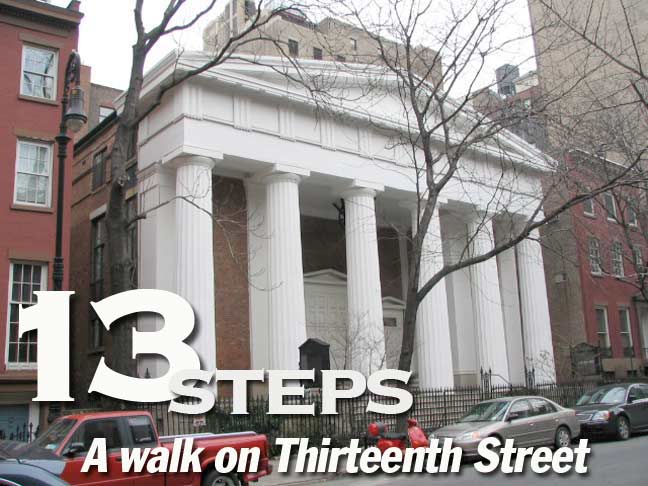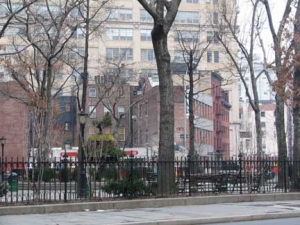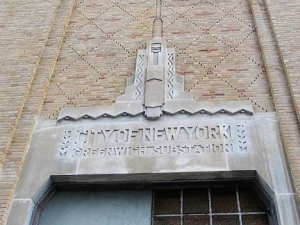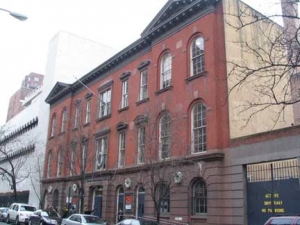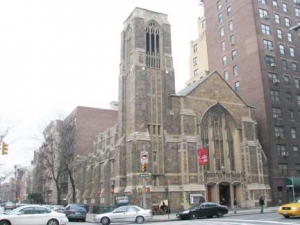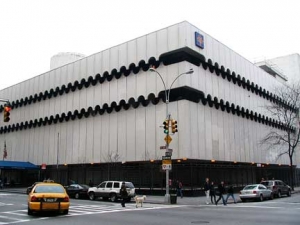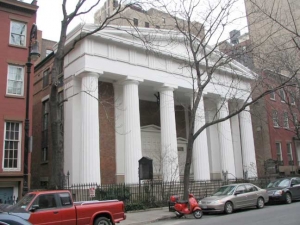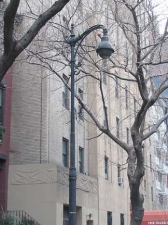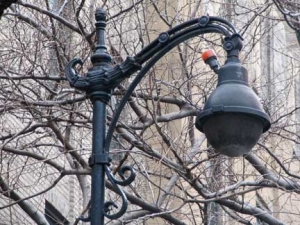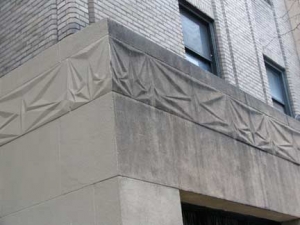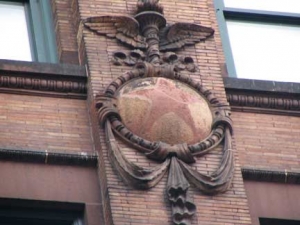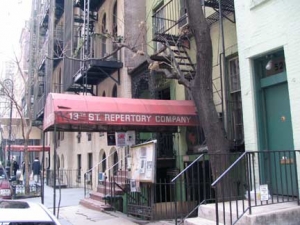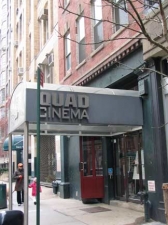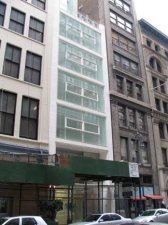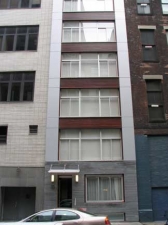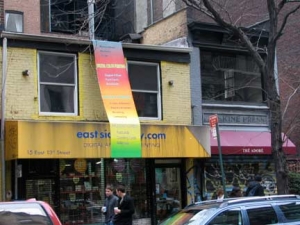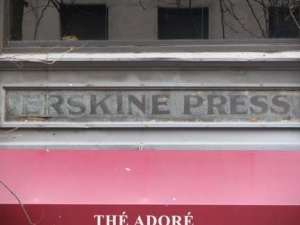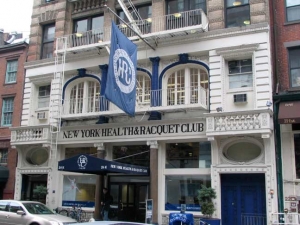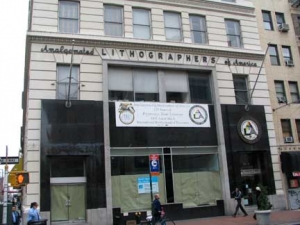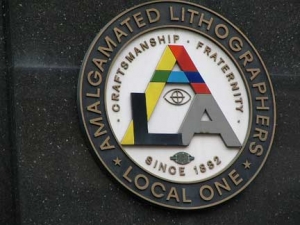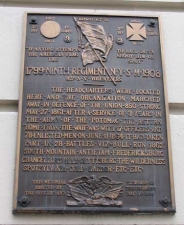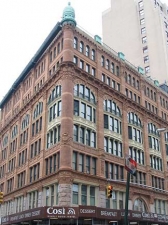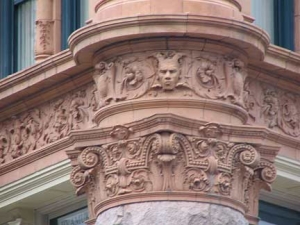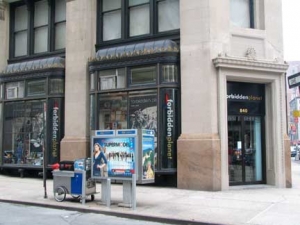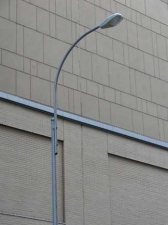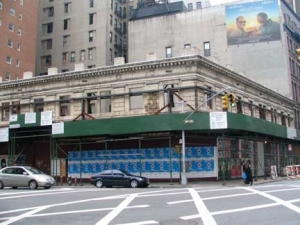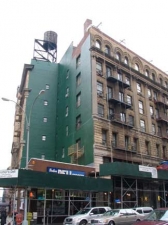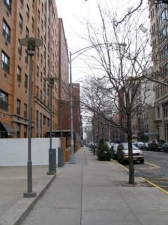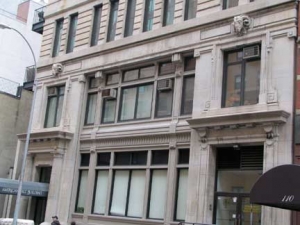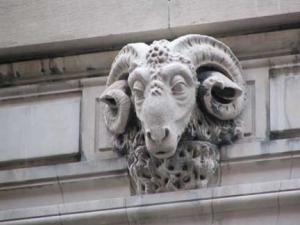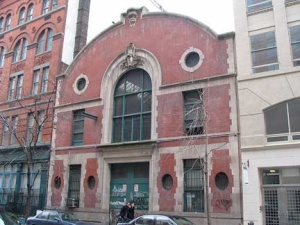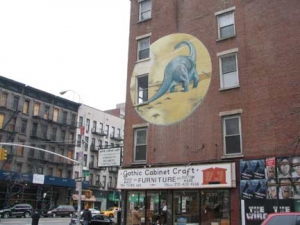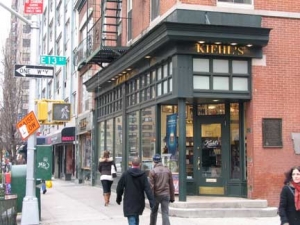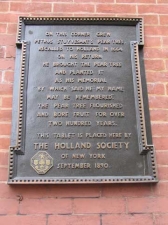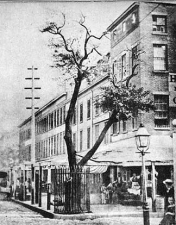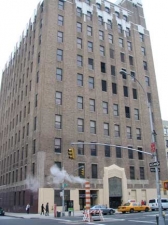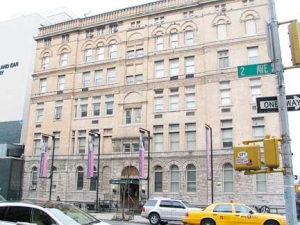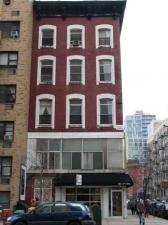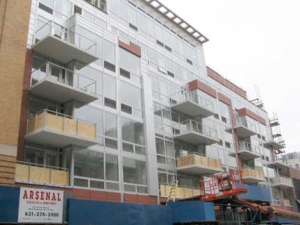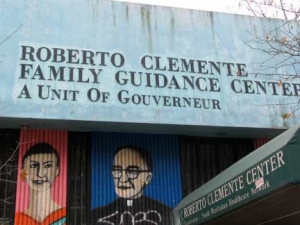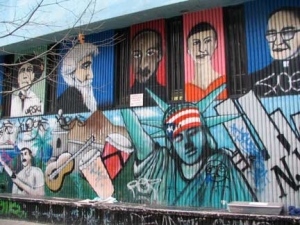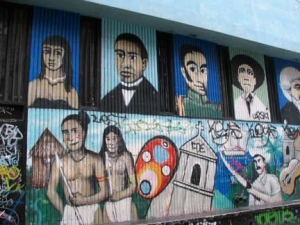Lucky thing Forgotten NY has a deep bench — on Saturday, January 19, 2008 I walked Fifth Avenue from Washington Square to Central Park, obtaining pictures for an upcoming page. When I got home I hooked up the camera to the computer, and my images appeared in the window of the program I use to store them, IPhoto (the newest version). Assuming the photos were actually in the computer, I dumped them from the camera…before importing them! Goodbye photos. The new IPhoto shows you the photos before it asks you to import them, unlike the older version. (It assumes you’re smarter than you are: deadly in your webmaster’s case.) A reshoot has been scheduled.
Meanwhile, I have plenty of other shoots to choose from. I chose a walk down 13th Street from 8th Avenue east to 1st Avenue earlier this month.
At West 13th Street’s western end, 8th Avenue invades the old Greenwich Village street plan from the north, creating a number of odd angles, inclusing one with Greenwich Avenue, one of the oldest paths in Manhattan. Where the two main avenues meet West 13th, you find Jackson Square Park.
It is not clear how, when, or why the site came to be called Jackson Square. Most likely it was named after Andrew Jackson (1767-1845), the seventh President of the United States. Born at Waxhaw Settlement, on the border of North and South Carolina, Jackson was elected to Congress in 1796 and served in the War of 1812. Old Hickory emerged as a national hero who was very popular with the leaders of Tammany Hall, New York’s most influential Democratic organization. With Tammany’s support, Jackson won the presidential elections of 1828 and 1832. On October 30, 1832, a hickory tree was planted in front of Tammany Hall, and its roots were nourished with the contents of a barrel of beer. NYC Parks
IND substation, West 13th just west of Greenwich Avenue. A FNY page chroncles original IRT substations around town, but this one is one of a number of IND substations, recognizable by the Machine Age design and lettering popular in the late 1920s and 1930s.
NYC’s substations that provided the electricity that powered the subways are no longer in use due to changing technology, but their distinctive surface entrances are recognizable by era.
This venerable building was the Food and Maritime Trades Vocational High School/PS 16, completed in 1887; today it is the National Museum and Archive of Lesbian and Gay History as well as a home to numerous gay and lesbian organizations.
Church of the Village, NW corner West 13th and 7th Avenues, built by architect Louis Jallade in 1932. It was formed by an unusual merging of three separate congregations in 2005.
Meanwhile on the SW corner, we find the St. Vincent Hospital’s O’Toole Medical Services Building, an unsual building compared in the AIA Guide to NYC Architecture to Frank Lloyd Wright’s Guggenheim Museum building (it’s an unusual design, for sure). It was completed in 1964 by Albert Ledner & Associates and revised in 1977.
I am told this was originally the National Maritime building…hence the wave-like designs.
The dominant structure on the north side of West 13th between 6th and 7th Avenues is the Village Presbyterian Church, now residences called Portico Place. Nothing at all was done to alter its exterior when the “conversion” was done in 1982…in fact the old signboard indicating the hymn numbers (from prayerbooks) was kept. The 6 Doric-columned building was finished in 1847, with further additions in 1855 and 1902. According to NY Songlines, before the conversion Protestant and Jewish congregations shared the space, but the synagogue moved after a disagreement during the 1973 Israel-Arab war.
One of the very few original Type F posts, which once lined Manhattan side streets by the flock. The rest of this block employs retro-Bishop Crooks. No ancient NYC lamppost is in place by accident by 2008–this one is likely historically designated.
A bunch of New Type Fs has been installed on West 8th Street from Broadway to 6th Avenue, as well as Wyckoff Avenue in Bushwick, Brooklyn, of all places. There are some originals to be found on Belt Parkway pedestrian bridges, and in SUNY Martime College campus in Throgs Neck, Bronx…but that’s about it for these former warhorses.
Beetling up behind the Type F is the 1929 Deco John and Mary Markle Memorial Residence (known as the Markle Evangeline Residence for Women), run by the Salvation Army as an international residence for business and professional women, graduate and undergraduate college students and senior citizens.
Crossing 6th Avenue and heading east we see on the north side a remnant of Macy’s when it was located on 6th Avenue and West 14th: a red star, the World’s Biggest Store’s symbol when it opened in the 1850s and stil the symbol now. I touched on the building’s history in a ForgottenSlice.
The 13th Street Repertory Company theatre has been here on the south side of West 13th at #50 since 1972. Israel Horovitz’ “Line” has played here since 1974. John Randolph, the late John Cazale, Richard Dreyfuss & Barnard Hughes have all appeared in the play (which examines the personalities of five people waiting in line) — the longest-running play in NYC at present.
42 West 13th, the Bakery Building, likely named for a former use. RIGHT: Quad Cinema, at 34. The Quad has been here for nearly 30 years and was one of Manhattan’s first multiplexes (with four screens, hence the name). In an era with humungous multi-screen theatres, NYC can still have small houses like the Quad, Film Forum, Angelica, Sunshine, etc that offer offbeat and foreign fare. The Quad mixes in major-studio releases too.
Your webmaster was once asked at a NYC photobloggers extravaganza at the Prince Street Apple Store if I liked any new buildings. “Sure,” I said, “as long as they aren’t crap.” I like these two modernist designs at #3 west 13th (right) and #5 East 13th (right).
Some of the smaller buildings between 5th Avenue and University Place, I hear, are slated to give way to a tall condominium apartment tower. One has the name of the long-gone Erskine Press. You will find an Erskine Press in Norwich, UK, but probably not the same folks. Author Anaïs Nin (1903-1977) self-published from this location.
24 East 13th, NY Health and Racquet Club, one of its 10 NYC locations. A building that looks this good might convince your webmster to join. NOT, though I might well take swim lessons at the Y this year.
Quite a mouthful: the Amalgamated Lithographers of America union headquarters at the SE corner of East 13th and University Place. The union was founded in 1882, became the ALA in 1915 and I like their current logo. Lithography, literally “stone writing,” is a method of printing text or artwork onto paper or another suitable material, invented in Germany in 1798.
This plaque on the corner at the ALA building honors the NY State 9th Regiment, organized as the 6th Regiment in 1799.
Bowlmor Lanes, 110 University Place. During the Age of Dinoaurs I was on my college bowling team, and we lost here at Bowlmor when there were stains on the carpets, cigar smoke swirling and the heady smell of bowling shoes in the air. Bowlmor is now one of NYC’s more popular nightspots, with glow in the dark bowling pins, a house DJ and lots more women.
A bronze tablet marking the location of the headquarters of the old 9th Regiment at Thirteenth Street and University Place, from which on May 27, 1861, the regiment, now 109 years old, marched to the front, 850 strong, was unveiled May 30, 1908, the ceremonies taking place at 11 o’clock after the regiment, which is now the 9th Coast Artillery Corps, N. G., N. Y., had participated in the Memorial Day parade.
Less than a score of veterans stood in the rain as Maj. Dabney W. Diggs, who got his rank for real service, and Col. William F. Morris, the present commander of the regiment, addressed them, but there were 800 then in olive drab standing at attention. The Colonel’s wife and his daughter-in-law and his granddaughter, seven-year old Maude Morris, who unveiled the tablet, sat on the platform on the southwest corner all the time without umbrellas and braved the downpour like the true daughters of soldiers.
Of course in the regimental armory in West Fourteenth Street there was something to warm other than dry clothing after it was all over and it isn’t likely that many of the soldiers will suffer from colds.
There is an eleven story business building where the two story headquarters of the 9th Regiment stood when Lincoln called for volunteers, and the tablet has been placed on the north side of the building in Thirteenth street a few feet east of University place.
It bears this inscription:
“If any one attempts to haul down the American Flag shoot him on the spot.”
1799; Ninth Regiment N. Y. S. M.; 1908. NY State Military Museum
Anyone know anything about this grand old campaigner at the NW corner of Broadway & 13th? Looks like a former department store. Perhaps the architect knew the guy with the horns on the corner.
Corner (839-841 Broadway): This 1893 building with a Cosi branch on the ground floor is named for Cornelius Roosevelt, Teddy’s grandfather, who lived up the block. The rooftop was the original site of Biograph Studios (1896-1908). –Songlines.
Forbidden Planet, Broadway and East 13th. Throughout the 1980s and into the 1990s I was in here once a month, in one of NYC’s premier comics and sci-fi centers (Jim Hanley’s Universe is the other.) Before his death John Lennon was a patron. It has been in this location about 10 years; before that, a block away on East 12th. It has a British counterpart.
It is of course named for the classic 1950s sci-fi movie in which Shakespeare’s The Tempest is staged on an alien planet, with Walter Pidgeon, Leslie Nielsen (before he began parodying himself) and Anne “Honey West” Francis.
Hybrid lamp. Unusual arrangement in which a mast from a Donald Deskey post is attached to an octagonal shaft.
A real estate development of a different type is across the street at the SW corner, as a Beaux-Arts building has been hollowed out and a new building will be stuffed inside. The most notable recent cognate is the Hearst Tower at 8th Avenue and West 58th Street.
4th Avenue and East 13th. A classic holdout, in which the owner of a property refuses to sell to a developer, who simply builds around him. The most notable cases were in Herald Square, where two owners of corner properties didn’t sell to Macy’s, and in Elmhurst, Queens, where a woman refused Macy’s and the World’s biggest store built a circular building with a notch cut out. Here, the wedge on the corner is the lagacy of someone who wanted to stay put.
Just east of 4th Avenue, a double-mast post is positioned at the back of the sidewalk. Why?
To allow fire engines out of the Ladder 3 firehouse, here since 1929, with the company here since 1865.
114 East 13th, the old American Felt Company building. Now residences. Felt is produced from rams’ wool.
Kearney & Van Tassel Auction Stables, 128-130, built 1889. Wide doorways like this in NYC usually indicate an old stables.
Very old chicken-wired windows mark a number of businesses on the north side, including the Flower Stall.
Yes, that is a dinosaur, a brontosaurus or diplodocus, at the SW corner of 3rd Avenue and East 13th.
What’s the story here?
NYU student Blake Larue attempted to discover the dinosaur’s artist.
The NE corner of 3rd Avenue and East 13th is historic in two ways: a pear tree planted by Peter Stuyvesant himself stood here in what was originally his farm from 1647 to 1867, a span of 220 years. It only perished when two horse-drawn wagons crashed into it. It’s a matter of serendipity that it wasn’t in the path of East 13th Street, which was cut through in the 1820s.
The plaque commemorating the long-lived tree was actually in the wrong place for 46 years, from 1959-2005!
The apothecary on the corner, Kiehl’s, has only been there since 1851, so the tree and the drugstore shared the space for 16 years.
In a unique setting that features the original crystal-drop chandeliers hanging from a 1930s acoustic-tile ceiling the sales staff, outfitted in white lab coats, dispense in-depth advice and generous samples of the many facial cleansers, scrubs, toners, moisturizers, masques, shaving, sunscreen, hair care and baby care products.
Kiehl’s continues to offer essences, including Original Musk Oil, a sample of which was discovered in the store’s basement in the 1920s and, since its reintroduction in 1963, has become the most widely imitated fragrance in the world… Ellen Williams & Steve Radlauer, The Historic Shops & Restaurants of New York
An Art Moderne tower, SE corner of 2nd Avenue and East 13th, a Verizon switching center, formerly AT&T.
Your webmaster gets his peepers peeped at in the historic NY Eye and Ear Infirmary, constructed in a Romanesque Revival style in 1893 on 2nd Avenue from East 13th to East 14th Street. Scenes from The Godfather were filmed within.
LEFT: 207 2nd Avenue. Top 3 floors: good. Bottom floor, not so good. RIGHT: new residential building, East 13th east of 2nd. Your webmaster has developed a soft spot for glass-front residences. Just make sure you have venetian blinds or curtains.
Mural, Roberto Clemente Family Guidance Center, just west of Avenue B.
ForgottenFan Lauren Williams: From left to right are: Dominican Indian Leader Anacona; Mexican Constitutional Reformer Benito Juarez, Liberator of South America Simon Bolivar, Puerto Rican feminist Luisa Capetillo, and Puerto Rican liberation leader Ramon E. Betances, Cuban independence leader Jose Marti, Puerto Rican poet Julia de Burgos, Salvadorean leader of the rights of the poor Archbishop Romero. To the extreme right, on the other side of the door, is the namesake, baseball Hall of Famer, Roberto Clemente.
Actress Rosario Dawson is absent, though she grew up on this block.
Thanks to Jim Naureckas’ New York Songlines for a lot of this page’s info.

